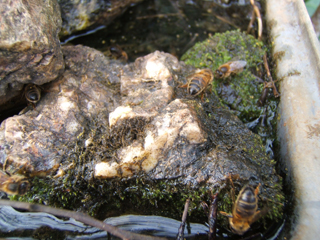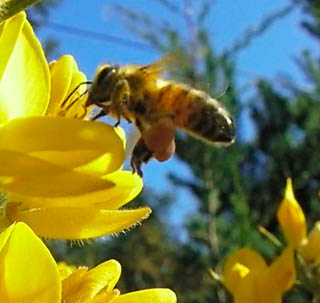 Hooray! At long last the bees are getting a chance to get out and about. One of the problems with long, damp winters is that there is greater potential for disease build-up in the bee colonies. As an example, which I describe to my beekeeping students, if there were 25 of us locked in a room during the winter with a window open (as it effectively is in a beehive during the winter), we would first of all become very cold. We would therefore likely huddle together to try to contain and share any warmth we were generating (like the bees do).
Hooray! At long last the bees are getting a chance to get out and about. One of the problems with long, damp winters is that there is greater potential for disease build-up in the bee colonies. As an example, which I describe to my beekeeping students, if there were 25 of us locked in a room during the winter with a window open (as it effectively is in a beehive during the winter), we would first of all become very cold. We would therefore likely huddle together to try to contain and share any warmth we were generating (like the bees do).
This would bring us into closer proximity with our fellow “confinees” so that we would also be sharing and breathing the air that they were exhaling to a greater extent than normal. This would tend to result in the transmission of germs from person to person and as more people picked up the germs they would add to the spread. Very quickly we would become a very unwell group of people with a great likelihood that, without treatment, some (the weakest) would perish, either through disease or cold.
It can be exactly that situation with the bees during the winter, especially if the weather is wet. So it is a heart-warming sight to see the bees flying once more, and last Tuesday even seeing young bees taking their first orientation flights outside the front of the hive whilst the sun was shining. Of course, temperatures are dropping like a stone very early in the afternoon, so the window of opportunity for the bees to take these flights is only small. However, they are getting out, even bringing in pollen and water when the conditions are right.

Pollen is the protein part of the bees’ diet. Without it, they will die. It is as important to their well-being as honey but the difference is that pollen deteriorates very quickly, even though it’s in the hive, whereas honey does not. This means the bees are having to bring in fresh pollen towards the end of winter (once the queen has started laying again) if they and their young are to survive. So it is really reassuring to see pollen going into the hive on these sunny, slightly warmer days. It means the queen has survived the winter and that she has started laying again now that the days are getting longer and the temperatures are rising (albeit for a very short period of time from mid-morning to early afternoon).
The honey that is in the hive at this time of year will be ivy honey, a honey which is very high in glucose and which therefore granulates in the comb to a very hard mass. The bees can’t utilise this without first diluting it with water, which they must find from somewhere (it is not stored in the hive). This means either sucking any water off the wooden surfaces inside the hive where it might have condensed owing to cold outside temperatures or taking flights to find water, which latter is a very risky business.
If the water source is not near the hive, the bees have to fly some distance, perhaps, to wherever it is, and during the time it takes to fly there, fill their honey stomachs with water, then fly home, the ambient temperature can drop to the point where the bees’ body temperature drops to 7ーC or less and they can die. Also, if the water source is in shade, the temperature of the water itself can be so low that it contributes to the drop in body temperature of the bee, thereby hastening the time it takes to drop to 7ーC and increasing the likelihood of death.
 It’s a tough life being a honeybee! Our role as beekeepers, therefore, is to try to make life easier for our charges, to enable their survival. We do this by monitoring the stores in the hive and, if the levels drop to a point where supplementation is required, we feed them with sugar syrup, baker’s fondant or sugar candy. I have not needed to do this for the past 2 years because the ivy flow in the autumn resulted in enough ivy honey in the brood boxes to see the bees through the winter.
It’s a tough life being a honeybee! Our role as beekeepers, therefore, is to try to make life easier for our charges, to enable their survival. We do this by monitoring the stores in the hive and, if the levels drop to a point where supplementation is required, we feed them with sugar syrup, baker’s fondant or sugar candy. I have not needed to do this for the past 2 years because the ivy flow in the autumn resulted in enough ivy honey in the brood boxes to see the bees through the winter.
However, I do help them with the provision of water near their hives. I have 2 old header tanks behind my hives at home, filled with stones and water and in full sun. The stones are there to stop the bees from drowning, as they tend to fall into water if they have nothing to hold on to. Also, the stones become covered in moss and algae over a period of time and the bees like nothing more than to suck the water from such growths, as they add important minerals to the water, which is a bonus. The bees quickly find these water sources at this time of year and can be seen on the stones drinking to their hearts’ content.
 Pollen is not a problem down here in Cornwall as we have gorse flowering almost non-stop throughout the year, and gorse is a very good source of pollen. At all my apiaries there is plenty of gorse growing in the hedgerows adjacent to the hives, so the bees can nip out to replenish their stocks any time there is a brief spell of sunshine. Beekeepers in other parts of the UK are not so lucky – they have to feed pollen patties to the bees because there are few hedgerows with gorse (especially on the east coast), since these have been grubbed out to make it easier to work the land with large-scale farming equipment.
Pollen is not a problem down here in Cornwall as we have gorse flowering almost non-stop throughout the year, and gorse is a very good source of pollen. At all my apiaries there is plenty of gorse growing in the hedgerows adjacent to the hives, so the bees can nip out to replenish their stocks any time there is a brief spell of sunshine. Beekeepers in other parts of the UK are not so lucky – they have to feed pollen patties to the bees because there are few hedgerows with gorse (especially on the east coast), since these have been grubbed out to make it easier to work the land with large-scale farming equipment.
I shall shortly be preparing my hives for queen rearing, as well as continuing to monitor the stores situation until the Spring flowers and trees start to bloom. This is an exciting time for us beekeepers – the start of a new season, with plans, hopes and new ideas for our bees just waiting for the right time to be put in place.
Colin Rees – 01872 501313 – colinbeeman@aol.com

